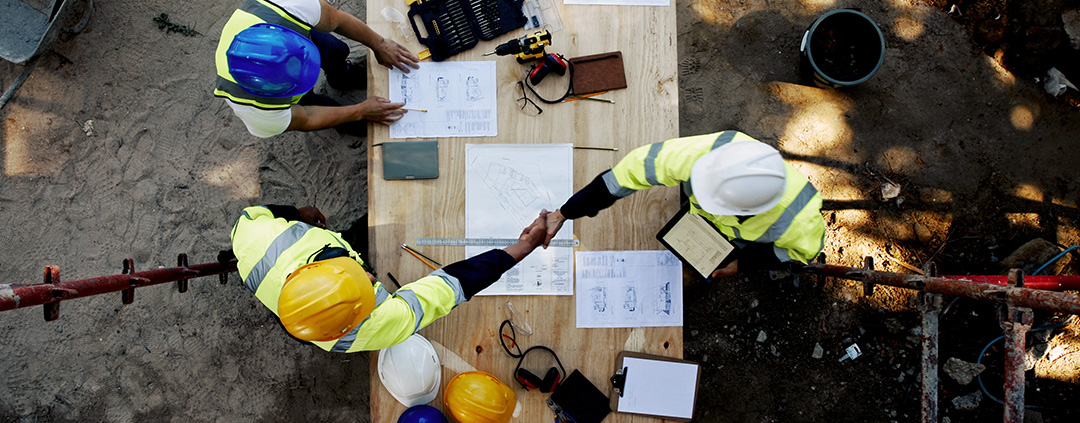Tag Archive for: construction industry
CGI Constructors: “Being a Builders Code Champion”
CGI Constructors Being a Builders Code Champion
An interview with Anthony Minniti, VP of Operations, CGI Constructors
Tell us when you signed the Builders Code Acceptable Worksite Pledge. What did you see as the benefits of signing the Pledge?
CGI signed early in the launch of the Builders Code. It represented a dramatically different commitment within the industry when issues regarding equity weren’t at the forefront. It wasn’t something where we were being reactive. It was a proactive methodology to pursue signing. As a company, we’re always trying to look at where things are going and where we can place ourselves as a leader within the industry. We saw the potential and all that came with the program. It was a no-brainer in terms of committing to the Builders Code and an acceptable worksite.
Why is it important? Why do you encourage others to sign the pledge?
Well, it’s a bit multifaceted. There is the company, the individuals within the company, the leadership, and then leadership at the worksite. There’s only an upside in terms of committing yourself, as a company and a workforce, towards a common goal of improving the entire industry.
From our perspective, it establishes a roadmap or a framework for all of us to interact with each other in a professional way—where everybody knows what to expect, and not one person or one entity is unbalanced in any of the relationships. So, we made the commitment to participate.
It’s easy to look at it proactively to refresh our thinking on a year-to-year basis as well.
You’ve been in construction for many years. If you compare worksites then and now, can you talk about how Builders Code can help move the industry forward?
Yes, I have been in construction since I was 17. So, 37 years.
Early on in my career, I accepted that there were situations of inequity on a construction site. There were certain people with power, and they would not treat everybody equitably.
Construction has changed in terms of communicating a respectful and equitable commitment to each other. I think there are still some bad players, people that are not acting in an equitable manner. However, the vast majority are treating people respectfully, are being loyal, and are working to say that we no longer accept these aspects within our industry. We’re just reaffirming a commitment and celebrating the facets within the community and within the industry that are about treating each other respectfully.
If you look at Builders Code as a recruitment tool, how do you explain it to a 17 year-old that is thinking about a career in the trades?
When a company signs the Builders Code Pledge, it represents a commitment that involves the leadership and staff.
Having a Builders Code badge on a company website indicates that these are the values the industry upholds, and they should consider a career in construction.
I think younger people appreciate joining a team that’s committed to a common goal.
What reason would you give to a company as to why they should sign the Builders Code Pledge?
Why not? It’s common sense. It’s something that we expect in our day-to-day lives: to be respected, to have a voice, and to feel comfortable in the place where we work. And why wouldn’t we, as owners, want that for our employees, no matter where their position is in the company, whether they’re out in the field or working in the office.
All sizes of companies strive to be seen as working towards a better business strategy. I would say that everything about the Builders Code represents how a company can work better to be a respectful leader and to have a comfortable environment for their employees.
Could you speak about the Builders Code training you’ve taken, the value you’ve gained from it, and any takeaways you’d like to share?
CGI was quite lucky to receive the original Builders Code training and then subsequent refreshments of the training. I would say that all aspects were very, very helpful.
The training was eye-opening, and the methodology of the learning was quite good because it had lots of examples. You were able to see an example of what could be happening on a job site, or happening between the office and the job site, or even happening between two individuals. You could listen to that scenario and then develop different and better ways to deal with the same situation.
The training gave you a toolbox of skills to deal with difficult situations – either a conflict, an abusive relationship on site, or a situation where somebody in leadership could be treating somebody else poorly. And that toolbox of skills was very, very helpful.
To have refreshers on the training and gain newer skills on a year-to-year basis was also good because it reminds you of some of the skills you might not have been using over the past year. I think another thing that was effective is doing the training in a group. Sometimes hearing what your colleagues or your staff are experiencing can be eye-opening.
I often use the phrase that somebody could be suffering in silence, and you might never know because they often choose to turn a blind eye. They have other management techniques. But being in a safe situation and sharing it was good because you could get very different perspectives from your team over very different periods of time. We had young staff, and we had staff that had been in their careers for 30 or 40 years. Feeling and hearing the entire gamut of their opinions was quite good.
It sounds like you’re describing the group sessions with a facilitator. Builders Code has various types of training, including self-directed training. Have you had a chance to explore that yet?
I’ve had the opportunity to experience some of the self-directed modules, and I think they just add a different flavor of learning. It’s the ability to learn at your own pace. It’s very interactive, it’s very comfortable. The great thing about it is when everybody’s under pressure, especially on sites and within the office, bringing everybody together in one spot can be very challenging. It’s also good because you can explore areas where you might not feel comfortable sharing with an entire team.
What are you, as a company, most proud of having achieved when it comes to creating and maintaining a positive workplace culture?
I think there’s probably two aspects to it.
The first aspect is that there’s an opportunity to constantly improve. As a company, we’ve been very committed to our employees. We have this statement that “we’re building Canada and we’re building Canada through our people”. If you’re committed to that strategy, there is this need to constantly improve, to recenter yourself, to be considerate of what a modern workplace might look like.
It helps us, as a company, recenter ourselves on a year-to-year basis. And when you’re reflective, you consider different aspects of your business. So not only are we considerate of our pledge to the Builders Code, but it’s also allowed us to look at some other functions within our business and help modernize them and recommit to some different strategies.
CGI has won a Builders Code Champion Award. What does winning an award like this mean for your company?
We were very proud to win this award. It was a culmination of a multi-year strategy within CGI to focus our attention very keenly on our people.
We focused on our people in multiple areas: their work environment, our commitment to having a safe, respectful workplace, and other improvements that we’re applying within our business.
This goes a far way in representing ourselves with potential employees, with our peers, and especially with our clients. It also helps represent us with our co-op students because it gives them, being junior in their careers, a sense of reassurance that they’re committing a four-month period of time to a place where they can be assured of a respectful learning environment.
And that kind of flows throughout the business.
What’s the advantage of that flowing throughout the business?
Well, some advantages are probably quite evident, and some might be a little more subtle. The evident ones are the morale within the organization improves; it’s a little easier to recruit new staff; and it’s definitely easier to recruit co-ops or young apprentices. That’s very tangible.
I think the more nuanced ones are where it challenges us in the rest of the business to raise our bar in the same way. This would include challenging all our vendors and sub trades who work with us to improve their behavior.
It’s not only the site dialog, the site behaviors, and the social behaviors on site that improve, it also improves the behavior of the entire team that’s supporting the site.
How should the construction industry continue to demonstrate the values of an inclusive construction culture? And why should they?
Well, the why, I think, is quite evident. The construction industry today is challenged with the decline of employees, mostly due to retirements. We’re in a situation where we’re out there actively recruiting in a very competitive marketplace, both for young students and young graduates from high school competing with technology-based careers.
We definitely want to present our industry, as well as our individual companies, as being positioned to acknowledge any shortcomings. We want to show that we acknowledge them and are willing to deal with them proactively – to show how we’re improving ourselves and have a vision for the future.
And ironically, our industry has never been afraid of those kinds of challenges. For example, during COVID, the industry hit that challenge head on from a health and safety perspective and endured. When we rally, we are very effective in how we get behind something.
Perhaps because we are made up of so many small companies or, we’ve always been lucky to be in a very robust, busy market, we didn’t focus on the issues as well as we should. I think we are now positioning ourselves to where an individual considering a change in their career can find themselves a place where they’re respected, where they feel they can grow in their career, and where they can be challenged. To ultimately not feel like a square peg in a round hole. They can find a home and certainly once they find their home, they can flourish.
Thank you, Anthony.
We’d like to thank you for your inspiring leadership in the industry, and for being a true champion of respectful workplace culture.
Wintering in West
Along with my position at the BC Construction Association (BCCA) where I assist with administrative work for BCCA’s Builders Code Program, I am a certified Yoga teacher, focusing my study and teaching on the 5 Elements of Chinese Yin. In the spirit of Builders Code values, which include appreciation of diversity and learning from different cultures, it’s fitting to start the New Year with valuable lessons from the Chinese 5 Elements philosophy.
Before I began learning about the 5 Elements, I would set a New Year’s Resolution following the fad, “New Year, New You” with new workout plans and the latest healthy food trends resulting in more doing and less being. With that came stress to keep up with society’s expectations. But the success of a New Year’s resolution goes deeper than just following the trend. It’s also about considering what these changes mean and how you’re incorporating them into your already busy life.
As I study and learn more about the 5 Elements philosophy and the Chinese Lunar calendar (celebrating the New Year on Jan. 29th), the connection between the elements and their correspondence with the seasons allowed me to embrace that connection with nature. Each element represents a season, wood-spring, fire-summer, earth-late summer, metal-autumn, and water-winter. In the Lunar calendar, spring ignites at the end of January. Nature in January is still hibernating, and human beings are a part of nature which is what made it easy to let go of the concept of a New Year’s resolution that pushes us to do more. January is not the time for more; it is the time to recharge, reflect, and rest.
Winter: The Season for Rest & Reflection
In western culture, there’s a lot of pressure to make New Year’s resolutions and set goals for the year ahead, but January follows what is typically a busy time of year for most, and many people are tired. What if you allowed yourself to be tired, and instead of continuing to be busy, you gave yourself time to rest? What if you followed the subtle calling of nature that says, it’s winter, time to hibernate, reflect, and recharge. As with nature, you are wintering.
Water is the element that represents winter in Chinese medicine. The colour is blue-black, the climactic factor is cold, and the energy quality is conserving. Winter is the most Yin time of year. Yin and Yang are important concepts in the Chinese 5 Elements philosophy as well as in Traditional Chinese Medicine (TCM). While Yin is about conserving energy, Yang is about movement, light, and activity, which is why it is at its highest peak in summer. Trying to burn through Yang energy when nature is telling us to conserve can lead to burn out.
During the winter months, my classes are slower to allow students to find stillness and rest – that same connection to what is happening in nature. It’s a time for personal reflection, allowing the seeds of our intentions that we are planting for the year ahead to soak up the water and rejuvenate in preparation for Spring. We’re in the darkest time of the year. It is cold, damp, and our primal instinct is to find a cozy setting. Whether that be spending more time at home, recharging alone or with family, taking gentle walks in the woods or by water, or maybe booking a warm, sunny vacation. Give yourself permission to nourish your body and mind.
By honouring the pause that darkness brings, releasing the pressures of “New Year, New You”, there comes freedom and peace within. By conserving energy through winter and taking time to ponder on the past year, you gain awareness and create space in your schedule for what you want when the Yang energy of Spring arrives.
“One should refrain from overusing the yang energy. Retire early and get up with the sunrise, which is later in winter. Desires and mental activity should be kept quiet and subdued. Stay warm, avoid the cold, keep the pores closed. The philosophy of the winter season is one of conservation and storage” (Maoshing, Ni. The Yellow Emperor’s Classic of Medicine. Boston: Shambhala, 1995. Print.6).
In our western world, we may not be able to get up with the sunrise, but we can find more nights to retire early, allowing ourselves to recharge under warm blankets to conserve our energy and make room for the goals and aspirations we have for the coming year. Give yourself permission to be still, to breathe, and to connect with the water element – washing away what no longer serves you, preparing the foundation for new developments in spring.
Blue Monday
January 20th, 2025 marks the 20th anniversary of UK Sky Travel’s press release coining the third Monday of January as “Blue Monday” the most depressing day of the year. In doing so, they considered numerous variables on why humans are so negatively affected by “Blue Monday”. Maybe their equation is correct, or maybe it’s pseudoscience, but the fact remains that by the third week of January we have been in the darkest days of the year for two months.
For all those who celebrated these recent holidays in December, it’s likely that your energy was overextended with what the holidays bring. If you haven’t been supplementing, your vitamin D is most likely deficient because of the lack of natural light. People may be struggling to maintain those resolutions because they continued to push themselves through the beginning of January. Now the exhaustion from the last two months and the disappointment of not being able to maintain that resolution catches up all at the same time.
In Traditional Chinese Medicine (TCM), you cannot heal the physical body without connecting your mind and emotions for complete healing. Our mental/emotional health and physical health are so deeply intertwined that it is difficult to start something new without considering the “whole-self.”
If you are a regular gym enthusiast or yoga practitioner such as me; the first few weeks of January can feel a little crowded with all the “resolutioners” starting their new healthy routine. But by the third week of January, you notice the crowd thinning because what lots of “resolutioners” forgot to do was make space in their life and schedule for this type of change. Altering your regular routine doesn’t happen overnight – preparation is key.
The top three New Year’s resolutions, which vary in order depending on demographics, are exercising more, improving one’s diet or losing weight, and improving finances. These intentions all take planning, time, and energy. They are all healthy goals if you’ve been mindful to realistically work them into your schedule. Lots of people get the winter blues or seasonal affective disorder (SAD). Some of those blues come from “I should.” I should be doing this, and I should be doing that, and I should be pushing myself. Don’t “should” all over yourself. Winter is not the time to push yourself; it’s a time to go inward and reflect. Embrace the dark season of winter, knowing the light is slowly building towards the Yang energy of the wood element for spring. Change and new routines are a beautiful thing, when you make room for them in your life and in your mind.
Our Builders Code program supports safety and well-being within the workplace for all. This includes finding ways to take care of our own physical and mental/emotional health. Anytime we start something new, it’s good to consider the emotional challenges and how to ease those challenges so we can be successful. We must give ourselves time and patience when we create a fresh start. Just as with the birth of spring, our own roots have been deeply planted and nourished from a winter rest.
Reference Links:
- The Yellow Emperor’s Classic of Medicine :A New Translation of the Neijing Suwen with Commentary By Maoshing Ni
- Settling into Stillness: Taoist Winter Wisdom for Yin Yoga | Teachers – Nyk Danu Yoga
- Blue Monday (January 20th, 2025) | Days Of The Year
- New Year’s Resolution Statistics By Age and Facts [2024*]
55 Years of Excellence: BCCA EBT’s Legacy in Empowering the Construction Workforce
The BCCA Employee Benefit Trust (EBT) is proud to celebrate 55 years of dedicated service to the construction industry’s workforce. Over the past five decades, we have remained steadfast in our mission to provide comprehensive, tailored benefits that address the unique needs of workers across British Columbia and Alberta. This anniversary serves as a reflection of our enduring commitment to the well-being of our members.
A Legacy of Service
For 55 years, the BCCA EBT has worked alongside industry employers to deliver benefit plans that enhance the quality of life for construction workers and their families. We understand the physical demands and fluctuating nature of the industry, and our benefits are designed to bring peace of mind, stability, and support to the workforce. We believe in a member-centric approach, offering coverage that goes beyond the basics to provide meaningful care and resources. Our plans continue to evolve to ensure members are supported in all aspects of their health—physical, mental, and financial.
Supporting Members Across Generations
The construction industry has seen significant change over the past five decades, from advancements in technology to shifts in workforce demographics. Throughout these changes, the BCCA EBT has remained a reliable partner to its members, adapting our offerings to ensure that our benefits continue to meet the needs of today’s diverse workforce. We take pride in the trust our members place in us, and that trust motivates us to continuously innovate and improve our services.
The Importance of Mental Health Support
Mental health is an important yet often overlooked aspect of overall well-being, especially in high-stress industries like construction. The BCCA Employee Benefit Trust (EBT) has long recognized the importance of mental health support for construction workers. Here’s how our benefits plans address mental health challenges and support a healthier, more productive workforce.
Construction work is demanding, and the associated stress can lead to mental health issues such as anxiety and depression. Addressing mental health proactively can improve job satisfaction, reduce absenteeism, and enhance overall productivity.
How BCCA EBT Supports Mental Health
- Comprehensive Resources: The BCCA EBT provides access to a variety of mental health resources, including counseling services, webinars, and digital therapy programs like iCBT. These resources help workers manage stress and mental health challenges effectively.
- Expanded Coverage: Our plans include extensive mental health benefits, ensuring that employees can access the care they need without financial barriers. Recent enhancements include coverage for digital therapy and additional psychology benefits beyond standard plan limits.
- Ongoing Adaptation: We continually update our mental health resources to address emerging needs. This commitment ensures that our members receive the most relevant and effective support available.
Looking to the Future
While we are proud of the accomplishments over the past 55 years, we are even more excited about what lies ahead. The BCCA EBT is committed to staying at the forefront of employee benefits, incorporating new technologies and expanding our support services to meet emerging needs. Our focus on mental health resources, digital therapy, and accessible care ensures that we remain relevant and responsive to the challenges that workers face today and in the future.
As we celebrate our 55th anniversary, we remain dedicated to providing the highest quality of benefits and support to the construction industry. Our focus is, and always will be, on the well-being of our members. Your peace of mind is our top priority, and we are here to assist you every step of the way.
For more information on benefit plans and what makes the BCCA Employee Benefit Trust unique, visit bccabenefits.ca, or email us or call us.
The Builders Code: Paving the Way for a Safer and More Inclusive Construction Industry
Chris Atchison, President of the BC Construction Association
As we navigate the complexities of the modern construction industry, one truth remains clear: our industry is not only about building structures, but also about building a workplace culture that supports the well-being, safety, and productivity of every worker on our job sites. At the British Columbia Construction Association (BCCA), we believe that a positive job site culture is essential for attracting and retaining skilled workers, enhancing productivity, and ensuring that everyone feels safe and respected. This is where the Builders Code comes into play.
The Builders Code is not just another initiative; it’s a groundbreaking commitment to transforming the construction industry from the ground up. It sets a standard code of conduct for job sites across British Columbia, addressing the urgent need to eliminate bullying, hazing, harassment, and discrimination. By doing so, we are fostering an environment where workers can thrive, free from the toxic behaviors that have too often been tolerated or overlooked in the past.
The Importance of the Builders Code
The construction industry has long been known for its tough, no-nonsense workplace culture. While this has contributed to a sense of camaraderie and resilience among workers, it has also, at times, perpetuated behaviors that can be harmful and counterproductive. Bullying, hazing, harassment, and discrimination are not just issues of personal conflict—they are significant barriers to the growth and sustainability of our workforce.
The Builders Code is our response to this challenge. It provides clear guidelines and expectations for behavior on job sites. It demonstrates the importance of ensuring psychological safety in the workplace. It helps to create a work environment where every individual is respected, valued, and empowered to perform at their best. By adopting the Builders Code, employers are making a powerful statement: they are committed to creating a safe and inclusive environment where all workers can succeed.
Assets Available to Employers
One of the most valuable aspects of the Builders Code is the range of resources and support it offers to employers. We understand that construction culture change doesn’t happen overnight, and that it requires a concerted effort from leadership at all levels. That’s why the Builders Code provides a comprehensive toolkit to help employers implement and uphold these standards on their job sites.
This toolkit includes everything from employee and leadership training modules and policy templates to on-site support and consultation services. These resources are designed to be practical and accessible, enabling employers to take immediate action to improve their workplace culture. Whether you’re a small contractor or a large construction firm looking for leadership courses, or for support in developing policies or onboarding new employees, the Builders Code has the tools you need to make a lasting impact.
A Statement of Leadership Commitment
Committing to the Builders Code is more than just a policy decision—it’s a statement of leadership. It signals to your employees, clients, and the broader community that you are dedicated to fostering a workplace that is safe, respectful, and inclusive. This top-down leadership commitment is essential for driving the workplace culture change that our industry so desperately needs.
But the Builders Code is not just about leadership from the top; it also reflects the bottom-up realities of job site culture. It acknowledges that the people who work on the front lines of our industry are the ones who experience these challenges most directly, and that their voices are critical in shaping the solutions. By embracing the Builders Code, we are creating a bridge between leadership and the workforce, ensuring that the standards we set are both meaningful and effective.
Looking to the Future
The Builders Code represents a significant step forward for the construction industry, but our work is far from done. As we continue to promote and expand this initiative, we are filled with hope for the future generation of builders who will benefit from the groundwork we are laying today.
Imagine a construction industry where every worker feels safe, respected, and empowered to contribute to their full potential. A workplace where diversity is celebrated, and where the best ideas and solutions are brought forward because everyone’s voice is heard. This is the vision that drives the Builders Code, and it’s a vision that we are committed to making a reality.
In closing, I encourage every employer in the construction industry to embrace the Builders Code. By doing so, you are not only investing in the well-being of your workforce but also in the future success of your business and our industry as a whole. Together, we can build a stronger, safer, and more inclusive construction industry—one that we can all be proud to be a part of.
Biography – Chris Atchison

President of the BC Construction Association (BCCA), Chris Atchison drives dynamic initiatives that introduce progressive and necessary change to industry while delivering value to all construction stakeholders across the province.
As President, Chris oversees many of the successful programs and strategic initiatives at BCCA, including Bid Central and Construction Month. Chris also leads workforce development strategies for the industry, championing such initiatives as the Skilled Trades Employment Program (STEP), Apprenticeship Services, Integrating Newcomers (IN), Building Builders, and Builders Code. He is passionate about promoting the construction industry as a high opportunity occupation, with a place for everyone.
Chris drives advocacy initiatives, including lobbying government for the enactment of prompt payment legislation, lien reform, and adjudication to the benefit of BC’s construction industry and economy. In addition, he is a staunch exponent of fair, open and transparent procurement practices.
Chris sits on several industry advisory boards, forums and councils, including:
- Deputy Minister and Industry Infrastructure Forum (DMIIF)
- National Advisory Council of Local Construction Associations for the Canadian Construction Association (CCA)
- Council of Construction Associations (COCA)
- Construction Foundation of BC (CFBC)
- BCCA Employee Benefit Trust (EBT)
As President of the BCCA, Chris is committed to moving the industry forward by maintaining essential relationships, modernizing policies, and embracing new technologies.










